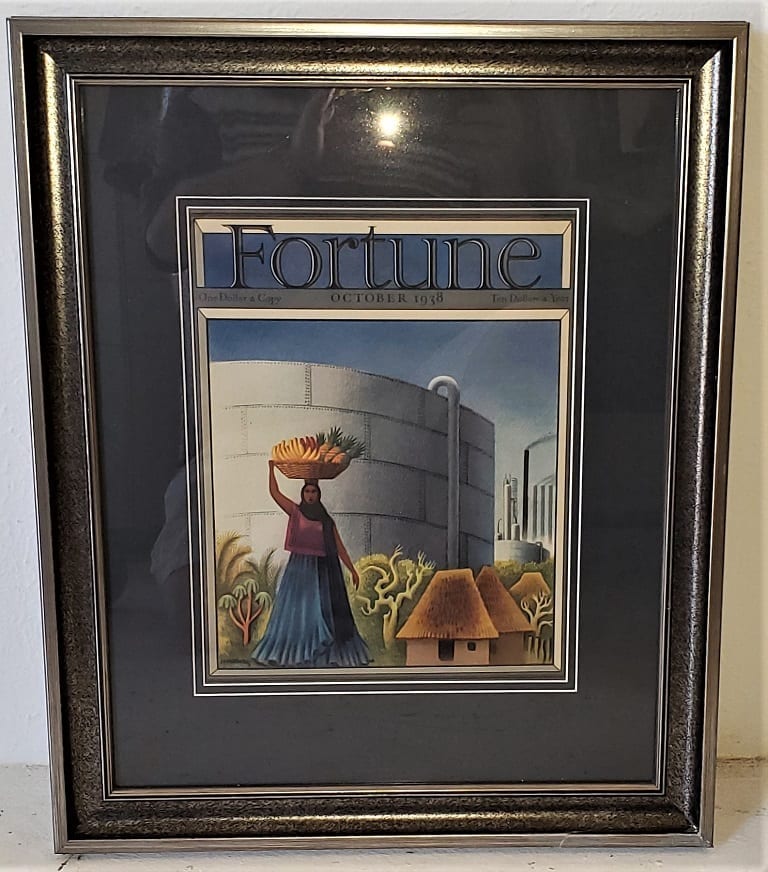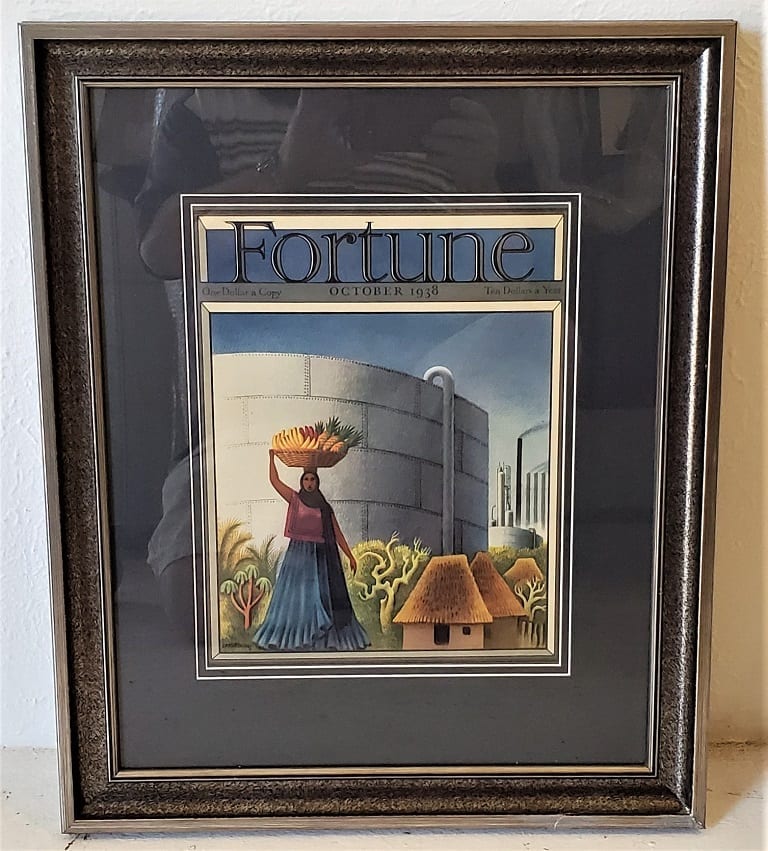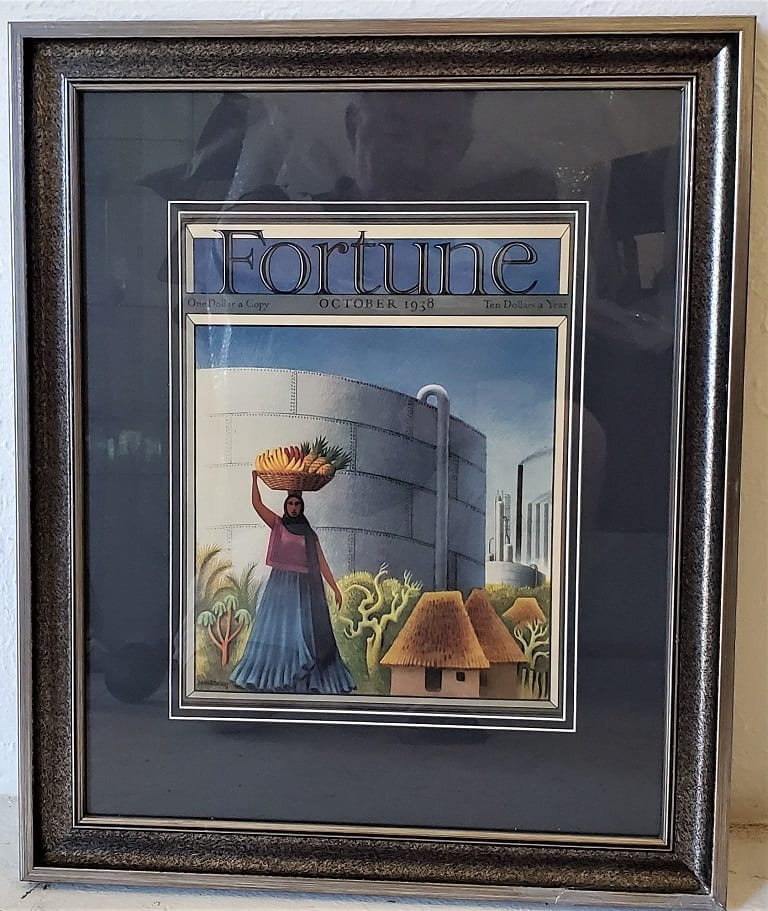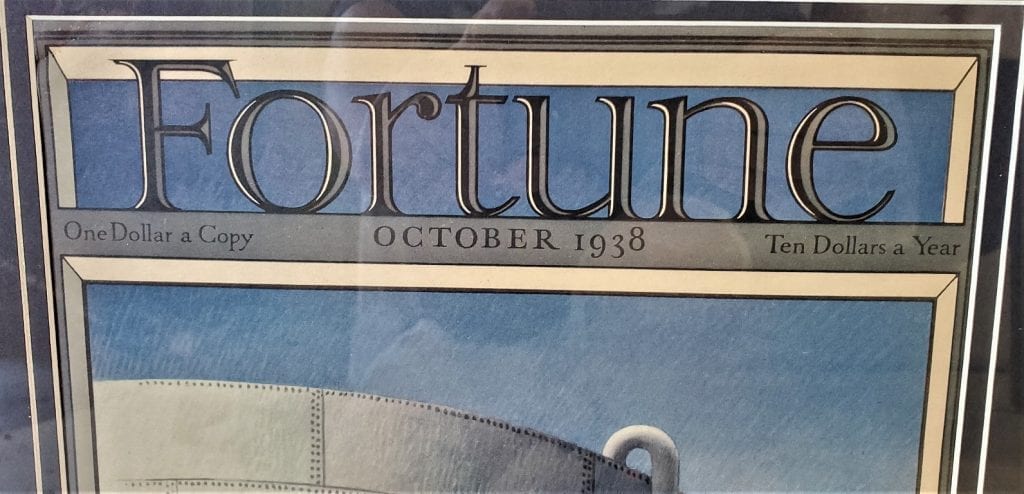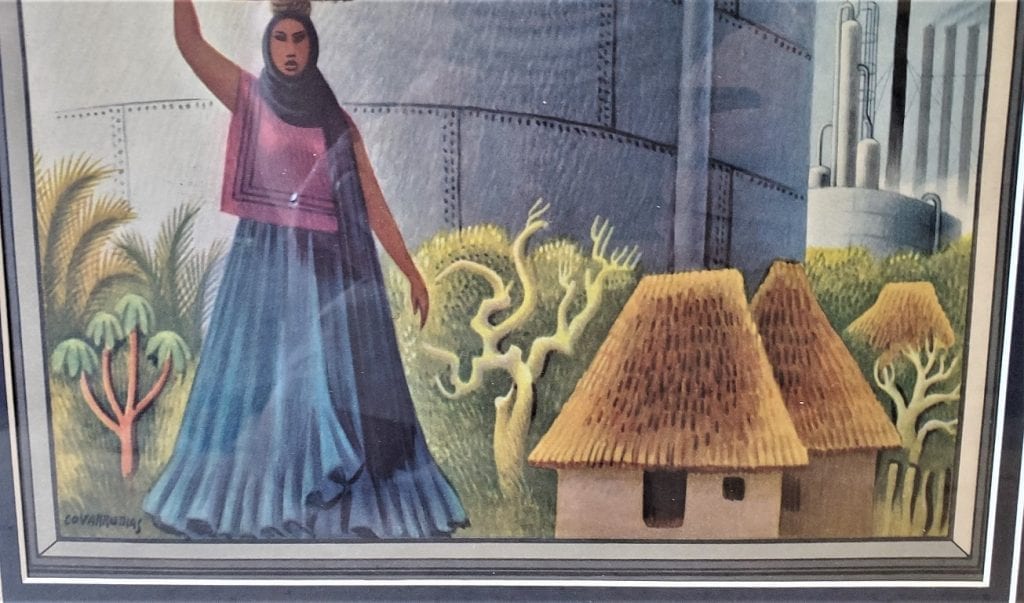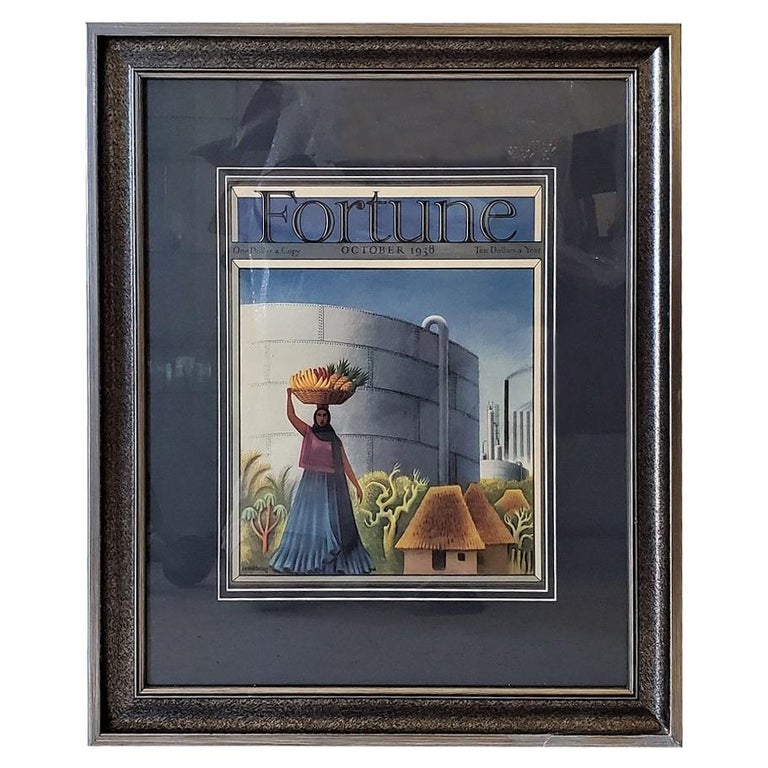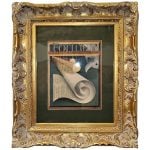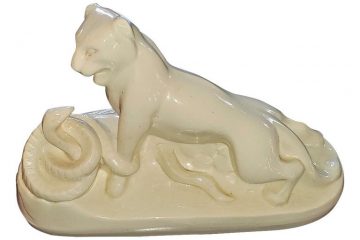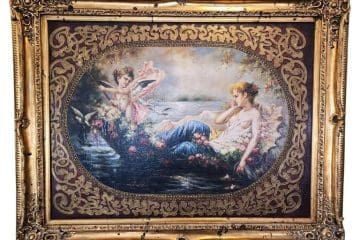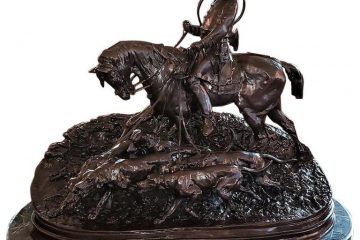Art Deco Fortune Magazine Cover – October 1938
PRESENTING a FABULOUS Original Art Deco Fortune Cover – October 1938.
The cover of ‘Fortune Magazine’ for October 1938, framed and matted.
This is an ORIGINAL COVER, not a re-print or copy. It is the cover of an actual 1938 Fortune Magazine and we can 100% certify it’s authenticity. We have attached a COA on the back of the frame.
The frame is modern. It is a silver, industrial style frame with black and white beveled matting. The frame and matting are perfect for the style of the era.
The cover print is an Art Deco depiction of an ethnic Hispanic Village and Lady carrying a basket of fruit on her head with industrialization in the background in CLASSIC ART DECO STYLE.
The cover is in near mint condition as can be seen from the photos.
This is one of the more iconic covers of Fortune.
Pained by ‘Covarrubias’ as noted and signed on the bottom left.
For more on Jose Miguel Covarrubias check out the following:
Miguel Covarrubias also known as José Miguel Covarrubias Duclaud (22 November 1904 — 4 February 1957) was a Mexican painter, caricaturist, illustrator, ethnologist and art historian.
Miguel’s artwork and celebrity caricatures have been featured in The New Yorker and Vanity Fair magazines. The linear nature of his drawing style was highly influential to other caricaturists such as Al Hirschfeld. Miguel’s first book of caricatures The Prince of Wales and Other Famous Americans was a hit, though not all his subjects were thrilled that his sharp, pointed wit was aimed at them. He immediately fell in love with the Harlem jazz scene, which he frequented with Rosa and friends including Eugene O’Neill and Nickolas Muray. He counted many notables among his friends including Zora Neale Hurston, Langston Hughes and W.C. Handy for whom he also illustrated books. Miguel’s caricatures of the jazz clubs were the first of their kind printed in Vanity Fair. He managed to capture the spirit of the Harlem Renaissance in much of his work as well as in his book, Negro Drawings. He did not consider these caricatures, but serious drawings of people, music and a culture he loved. Covarrubias also did illustrations for George Macy, the publisher of The Limited Editions Club, including Uncle Tom’s Cabin, Green Mansions, Herman Melville‘s Typee, and Pearl Buck‘s All Men Are Brothers. Heritage Press, the sister organization of The Limited Editions Club, reprinted unsigned editions. In addition he did illustrations for publisher Alfred & Charles Boni’s Frankie and Johnny for a young writer who would become a good friend and film director named John Huston. Today, these editions are very sought after by collectors. He collaborated in Austrian Artist Wolfgang Paalen‘s journal Dyn from 1942–44. Additionally his advertising, painting and illustration work brought him international recognition including gallery shows in Europe, Mexico and the United States as well as awards such as the 1929 National Art Directors’ Medal for painting in color for his work on a Steinway & Sons piano advertisement.
Painting
Covarrubias was invited by the 1939-1940 Golden Gate International Exposition (GGIE) that was held on Treasure Island, “to create a mural set entitled Pageant of the Pacific to be the centerpiece of Pacific House, ‘a center where the social, cultural and scientific interests of the countries in the Pacific Area could be shown to a large audience.'” Covarrubias painted the six murals for GGIE in San Francisco with his assistant Antonio M. Ruiz. The set of murals featured oversized, “illustrated maps entitled: The Fauna and Flora of the Pacific, Peoples, Art and Culture, Economy, Native Dwellings, and Native Means of Transportation. These murals were immensely popular at the GGIE and were later exhibited at the American Museum of Natural History in New York. Upon returning to San Francisco, five of the murals were installed at the World Trade Club in the Ferry Building where they hung until 2001. The whereabouts of the sixth mural, Art and Culture, are unknown and has been the subject of great speculation.”
The Fauna and Flora of the Pacific mural is now on display at the de Young museum in San Francisco. “The colorful map depicts the four Pacific Rim continents with examples of their flora and fauna suspended in a swirling Pacific Ocean populated with sea creatures.”
Covarrubias’ style was highly influential in America, especially in the 1920s and 1930s, and his artwork and caricatures of influential politicians and artists were featured on the covers of The New Yorker and Vanity Fair.
Covarrubias is also known for his analysis of the pre-Columbian art of Mesoamerica, particularly that of the Olmec culture, and his theory of Mexican cultural diffusion to the north, particularly to the Mississippian Native American Indian cultures. His analysis of iconography presented a strong case that the Olmec predated the Classic Era years before this was confirmed by archaeology. In his thesis of a final cultural battle between Olmecs and Maya he was encouraged by his friend, the Austrian Surrealist and ethnological philosopher Wolfgang Paalen, who even went so far to describe the conflict as one of ancient matriarchal culture with new patriarchal orientations in Maya culture with its dominant adoration of the male sun-god Kukulkan. Both Paalen and Covarrubias published their ideas in Paalen’s magazine DYN. Covarrubias interest in anthropology went beyond the arts and beyond the Americas—Covarrubias lived in and wrote a thorough ethnography of the “Island of Bali“. He shared his appreciation of foreign cultures with the world through his drawings, paintings, writings, and caricatures.
Link: https://en.wikipedia.org/wiki/Miguel_Covarrubias
Fortune was founded by The Atlantic Monthly Company co-founder Henry Luce in 1929, as “the Ideal Super-Class Magazine”, a “distinguished and de luxe” publication “vividly portraying, interpreting and recording the Industrial Civilization”. Briton Hadden, Luce’s business partner, was not enthusiastic about the idea – which Luce originally thought to title Power – but Luce went forward with it after Hadden’s sudden death on February 27, 1929.
In late October 1929, the Wall Street Crash of 1929 occurred, marking the onset of the Great Depression. In a memo to the Time Inc. board in November 1929, Luce wrote: “We will not be over-optimistic. We will recognize that this business slump may last as long as an entire year.” The publication made its official debut in February 1930. Its editor was Luce, managing editor Parker Lloyd-Smith, and art director Thomas Maitland Cleland. Single copies of the first issue cost US$1 ($15.3 in 2019). An urban legend says that Cleland mocked up the cover of the first issue with the $1 price because no one had yet decided how much to charge; the magazine was printed before anyone realized it, and when people saw it for sale, they thought that the magazine must really have worthwhile content. In fact, there were 30,000 subscribers who had already signed up to receive that initial 184-page issue. By 1937, the number of subscribers had grown to 460,000, and the magazine had turned half million dollars in annual profit.
At a time when business publications were little more than numbers and statistics printed in black and white, Fortune was an oversized 11″×14″, using creamy heavy paper, and art on a cover printed by a special process. Fortune was also noted for its photography, featuring the work of Margaret Bourke-White, Ansel Adams, and others. Walker Evans served as its photography editor from 1945 to 1965.
During the Great Depression, the magazine developed a reputation for its social conscience, for Walker Evans and Margaret Bourke-White‘s color photographs, and for a team of writers including James Agee, Archibald MacLeish, John Kenneth Galbraith, and Alfred Kazin, hired specifically for their writing abilities. The magazine became an important leg of Luce’s media empire; after the successful launch of Time in 1923 and Fortune in 1930, Luce went on to launch Life in 1936 and Sports Illustrated in 1954.
From its launch in 1930 to 1978, Fortune was published monthly. In January 1978, it began publishing biweekly. In October 2009, citing declining advertising revenue and circulation, Fortune began publishing every three weeks. As of 2018, Fortune is published 14 times a year.
Link: https://en.wikipedia.org/wiki/Fortune_(magazine)
Art Deco, sometimes referred to as Deco, is a style of visual arts, architecture and design that first appeared in France just before World War I. Art Deco influenced the design of buildings, furniture, jewelry, fashion, cars, movie theatres, trains, ocean liners, and everyday objects such as radios and vacuum cleaners. It took its name, short for Arts Décoratifs, from the Exposition internationale des arts décoratifs et industriels modernes (International Exhibition of Modern Decorative and Industrial Arts) held in Paris in 1925. It combined modern styles with fine craftsmanship and rich materials. During its heyday, Art Deco represented luxury, glamour, exuberance, and faith in social and technological progress.
Art Deco was a pastiche of many different styles, sometimes contradictory, united by a desire to be modern. From its outset, Art Deco was influenced by the bold geometric forms of Cubism and the Vienna Secession; the bright colors of Fauvism and of the Ballets Russes; the updated craftsmanship of the furniture of the eras of Louis Philippe I and Louis XVI; and the exotic styles of China and Japan, India, Persia, ancient Egypt and Maya art. It featured rare and expensive materials, such as ebony and ivory, and exquisite craftsmanship. The Chrysler Building and other skyscrapers of New York built during the 1920s and 1930s are monuments of the Art Deco style.
In the 1930s, during the Great Depression, Art Deco became more subdued. New materials arrived, including chrome plating, stainless steel, and plastic. A sleeker form of the style, called Streamline Moderne, appeared in the 1930s; it featured curving forms and smooth, polished surfaces. Art Deco is one of the first truly international styles, but its dominance ended with the beginning of World War II and the rise of the strictly functional and unadorned styles of modern architecture and the International Style of architecture that followed.
Link: https://en.wikipedia.org/wiki/Art_Deco
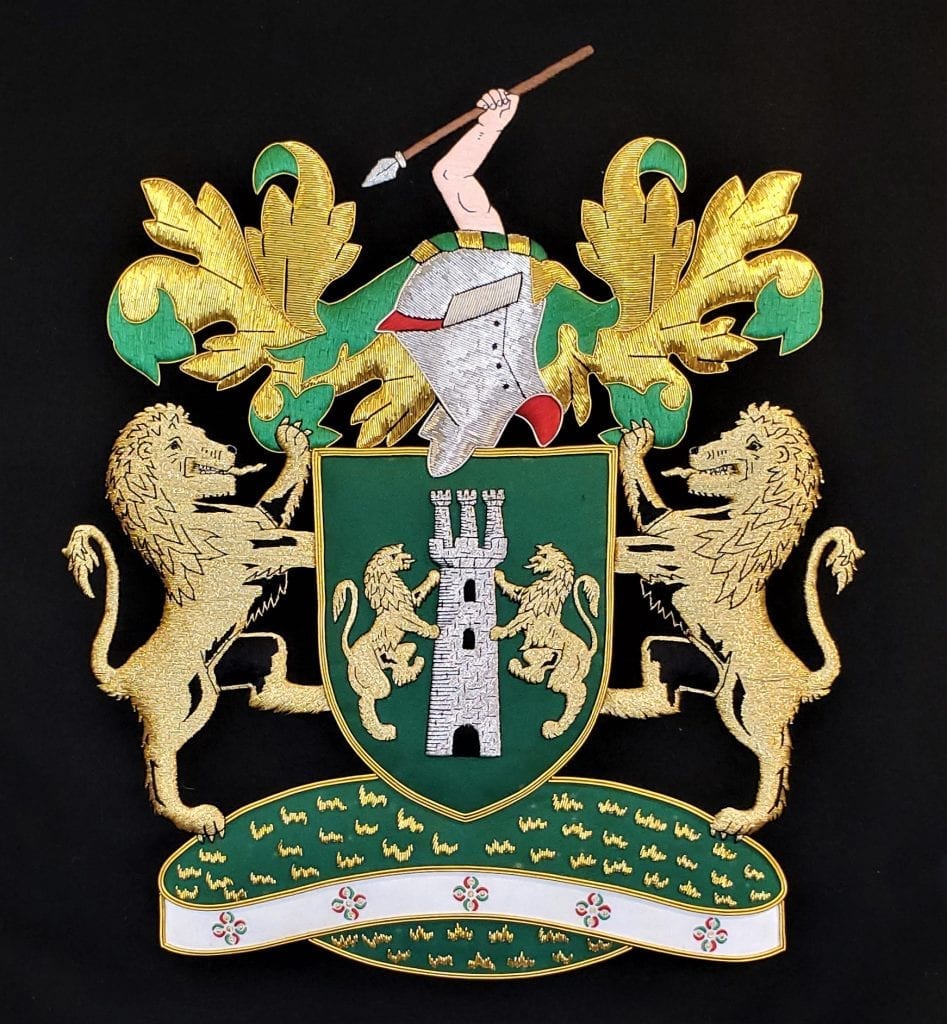

Art Deco Fortune Magazine Cover – October 1938.
Provenance: From a Fine Dallas Estate.
Condition: Very good. Slight repair to bottom right of frame, but not noticeable.
Dimensions: In Frame: 24 inches Tall, 20 inches Wide and 1 inch Deep
SALE PRICE NOW: $475
